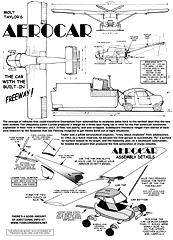
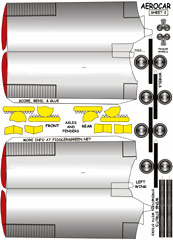
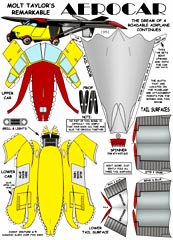
The Taylor Aerocar-Flying Car

A true FLYING CAR:
 The Taylor Aerocar was a roadable aircraft that first used 150-h.p.
Lycoming for either prop or wheel drive with propeller located
at cabin rear.
The Taylor Aerocar was a roadable aircraft that first used 150-h.p.
Lycoming for either prop or wheel drive with propeller located
at cabin rear.
The later versions shifted the prop aft of tail. Standard equipment
were clutch and brake pedals and all air and ground lights and
other instruments required by vehicle codes. The Flying Car towed
it's wings and tail as a trailer while on the road.
This delightful little model can be displayed from the ceiling
in flying mode hanging at the end of a thread or on the shelf
in trailer mode as shown.
IDENTITY CRISIS:
Is it a car? Is it a plane? Really,
the Aerocar was neither. At least
not in a good way. It was
horrible on the ground and even
worse in the air. Ingenious it may
have been, but useful it wasn't.
Chip, You wild and crazy guy!!! The Aerocar is the Bees Knees of coolness from the world of wacky general aviation aircraft! So, what's next? Marc (3/03)
It's cute as a bug. hmmm, is there a model of a VW around? Mate the wings and tail to the VW. The "Volksfluegel" Ja? could be the start of something big. ;-) Bob (3/03)
Great looking model. Added another one to my build list. Had a rare opportunity to see one fly last summer at Airventure. Pretty cool. Mike (3/03)
Great model, great site. I love to visit Fiddlers even just to look around and read the additional info. Keep designing! Joe (3/03)
Chip..Just a short thank you once again for a great model....You are right! I love the models that you can't get in plastic...Keep up the great work.....Ken (3/03)
The Flying Car looks great! I can't wait to build one! There are still people out there with that dream. The Molar Aircar is a current one. But, what a nightmare it would be if those were an everyman machine as the early dreams involved. I can't even begin to imagine the carnage during the early morning commutes! It is terrible enough with cars and SUV's, just think if all those Bozos were flying!!! Keep up the great work. BoB H (3/03)
Chip this worked fine thank you, great looking model. In 1951, I was in Ft. Bragg and saw some weird looking planes flying over. One of them was the Aerocar. Later, I saw it on the street. If I remember correctly, there were more than one kind of aircraft. I was told they were trying to sell it to the Army. Thanks again , keep up the good work. Lyndell Caldwell
Taylor's Aerocar- One Man's Dream Takes Flight In A Flying Car!

 American inventor Moulton Taylor's dream of a 'roadable aircraft' saw construction of a series of novel,
but largely impracticable, vehicles over 20 years, none of which reached series production. The Aerocar
was one of several failed attempts to combine motoring and aviation.
American inventor Moulton Taylor's dream of a 'roadable aircraft' saw construction of a series of novel,
but largely impracticable, vehicles over 20 years, none of which reached series production. The Aerocar
was one of several failed attempts to combine motoring and aviation.
Taylor's Aerocar I flew in 1949 but was not certified until 1956. Six were built, followed by a non- roadworthy version called the Aero-Plane and finally the definitive Aerocar III in 1968. The Aerocars were essentially small, lightweight cars with detachable conventional light aircraft wings and an unusual Y-tail with a pusher propeller.
New rules on automobile safety in the 1970s required additional equipment for the car component of the Aerocar, such as bumpers, which increased the weight and expense and reduced performance. Plans to build a sleeker sportscar version were dropped.
Molt Taylor's Aerocar still serves as an inspiration for the new generation of roadable designers and dreamers.
The Aerocar flight instructions went something like this: "It's easy. It practically flies itself. I'll tell you what to do as we go along."
In the summer of 1959, Moulton Taylor, with a little time on his hands and the zeal of a missionary, was seeking another convert. He'd given his student, a recent high school graduate named Ed Sweeney, the use of his Longview, Washington sod runway to fly radio controlled model aircraft.
But this was no model. Nor was the four-wheel vehicle Sweeney steered down the runway strictly an airplane. Had Taylor stripped the craft of its wings and tail section, Sweeney could have signaled a couple of turns and driven into town, as Taylor sometimes did, on a head-turning jaunt to the grocery store.

With Taylor at his side, Sweeney left the ground at about
55 mph. "Okay, we're high enough," said Taylor.
"Let's make a turn." Sweeney dialed the steering
wheel and the Aerocar quickly responded. The landing was equally
smooth. "Just drive it down the runway," said Taylor,
"and when you're ready to stop, simply step on the brake."
Sweeney enjoyed his brief drive in the sky, but his encounter
with the Aerocar was not love at first flight. "It didn't
mean all that much to me at the time," The media has
always loved flying cars, particularly Molt Taylor's Aerocar.
Taylor, the dean of roadable airplanes, devoted most of his
adult years to making the Aerocar a reality. The Aerocar IV,
is based on a Geo Metro.
Aviation historians consign the flying automobile to the oddity hangar, a niche reserved for the Spruce Goose, the autogiro, and other noble though quirky experiments. But if a flying car has yet to attain success, the idea of one is still very much alive.
The thinking of the time was that there was a need for such a dual-purpose vehicles. "Not only are roadways more congested with each passing year, but the airlines' hub-and-spoke system has, over many mid-length routes, actually increased travel times. But that's only part of what inspired flying car designers. As Chuck Berry sang in his 1956 recording "You Can't Catch Me," the ability to transform a car into a plane is liberating-freedom at the push of a button:
"I bought a brand new Airmobile. Custom made, 'twas a flight de ville. With a powerful motor and some highway wings, Turn off the button and you will hear her sing. Now you can't catch me. Baby, you can't catch me. 'Cause if you get too close, you know I'm gone ......Like a cooool breeze. |






But the flying car remains a romantic vision, a kind of aeronautical mirage. The challenges of building one are perhaps exceeded only by the challenges of selling it. Because a vehicle worthy of both land and air has compromise written all over it, the technical challenges are numerous. The common elements are few- fuel tank, steering wheel, passenger and baggage compartments, wheels, and engine. For flight you need wings, ailerons, a horizontal stabilizer, a vertical tail, rudder, elevators, and a propeller, none of which has any business on a car. For the road, you need a drive train and bumpers, not to mention rear-view mirror and, nowadays, catalytic converters-all dead weight in the air. The history of flying cars can be written in a single sentence: As airplanes, they've all been too heavy.
Still the quest goes on with imaginative and divergent approaches, which range from simple kit-built vehicles to a James Bond-like concept -with sleek lines and telescoping wings. (Even 007 himself hasn't seen a real flying car. The one in The Man With the Golden Gun was a static model "flown" by Hollywood special effects.)
One of the most credible still belongs to Molt Taylor. Taylor got some publicity through his own efforts, like storing the Aerocar in his garage. When actor Bob Cummings acquired an Aerocar and featured it on his TV show, Taylor hoped sales would really take off.
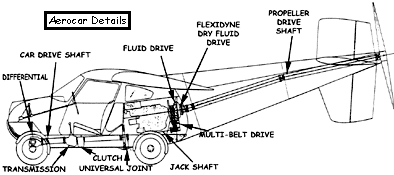
Taylor was revered as a kind of patron saint of the flying car. "Oh, I had a ball," he says with a high-pitched chuckle. Visitors to his home in Longview would hear his string of stories-like the time he got a speeding ticket in Florida while driving an Aerocar to an auto show. And once, while delivering an Aerocar to pilot and actor Bob Cummings, Taylor made a spur-of-the-moment stop at an Earl Scheib paint shop.
After verifying that, yes, the $39.95 two-color rate was good for any car, Taylor had them match the yellow and green colors of NutraBio, the vitamin company that sponsored"The Bob Cummings Show," on which the Aerocar would thereafter regularly appear in the early 1960s. Taylor himself was on TV countless times. His favorite appearance? The time he drove the Aerocar onto the stage of "I've Got a Secret" and, with the help of an assistant and while answering the questions of the blindfolded panel, went about the car-to-plane conversion. Three minutes later there was an airplane sitting there.
Taylor was a gifted aeronautical engineer, "crazy about airplanes" from adolescence. In 1942, as a Naval reservist, he became the first person to successfully "fly" a surface-to-surface missile to its target, and the following year, as a lieutenant commander, he headed the project that produced the first generation of cruise missiles. His resume also includes home built aircraft Re; the Coot, an amphibious "floatwing" plane, and the Imp and Mini-Imp, two types of one-place sportplane with an inverted V-tail. An early version of an Imp helped launch his flying car quest. In 1946, while shopping for a plant in New Castle, Delaware, to build an amphibious sportplane he was then calling the Duckling, Taylor bumped into Robert E. Fulton Jr., soon to be heralded in Life magazine for his flying car, the Airphibian.
Taylor was impressed with Fulton's incarnation of a winged automobile as was the Civil Aeronautics Administration, which later awarded it a type certificate, the first of only two flying cars ever certified for production (the other was Taylor's Aerocar).
"I saw it fly and watched him leave the wings and tail behind and drive off in the car," says Taylor. "I thought that a good idea. But I can do better." Taylor reasoned that if the whole idea of a flying car was that it would give you the freedom to go where you pleased when you pleased, then leaving behind the flight components was a less than optimal engineering solution. His design put the wings, tail, and rear-mounted propeller into a trailer towed behind the car.
To keep the weight down, Taylor fashioned the car's outer
panels out of fiberglass, years before the Corvette startled
the automotive world with its composite skin. And, because
the rear wheels were used for landing, the Aerocar employed
what was then an automotive oddity: front wheel drive.The
toughest engineering challenge proved to be dampening the
power pulses, or torsional resonance, in the 10-foot-long
drive shaft connecting the Aerocar's Lycoming engine to its
pusher propeller. After months of investigating vibration
dampers, Taylor read about a little known French dry fluid
coupling called a Flexidyne. In this clutch, tiny steel shot
was pac ked into a nearly solid mass that absorbed the engine's
power pulses.
ked into a nearly solid mass that absorbed the engine's
power pulses.
Taylor's Aerocar Incorporated turned out a prototype and four more examples of the design known as Aerocar 1. In 1961, Portland, Oregon radio station KISN bought one for traffic reporting. That was also the year Taylor first glimpsed a bit of financial blue sky. He'd struck a deal with Ling-Temco-Vought, a Dallas-based company. They'd build 1,000 Aerocars at a projected cost of about $8,500 a piece, provided he could round up 500 firm orders. In two weeks he collected 278 deposits of $1,000 each and forwarded the money. But without another 222 orders, the deal fizzled.
Nine years later, Taylor's hopes rose again when Ford Motor Company took an interest in the Aerocar 111. (the Aerocar 11 was a four-passenger flight-only fuselage.) The Model III had fully retractable wheels, which cut drag and boosted cruise speed 10 percent to nearly 120 mph. Lee Iacocca sent Donald Petersen, a vice president of product planning and research (and later the company's chairman), and Dick Place, a Ford executive with a pilots license, to meet with Taylor in Longview.
Place's logbook dates his Aerocar flight to August 1970. He recalls being sufficiently impressed with both the flight and highway performance to suggest that Ford "at least take the next step or two investigating the possibilities." But in the face of the oil crisis and increased importation of Japanese cars, the company's interest cooled. And Place speculates that the career-minded Petersen probably didn't want to be "weighed down with advocacy of what most people would think of as a harebrained device."

Taylor made headlines with his Aerocars, but no money. In his basement was a huge library of videotapes, most of them made from Super-8 footage. "Look at it go, boy," he would say. "Now watch how smooth it lands. "'Here's Taylor, wearing a fedora, standing on the old sod runway. He hears himself pounce on an interviewer's question: "If it weren't for us nuts, you'd still be reading from candlelight and wearing button shoes.... The flying automobile is the future. It The marriage of automobile and airplane began early in the history of both vehicles. In 1917, just 14 years after the Wrights first flew and nine years after Henry Ford introduced the Model T, visitors to the Pan-American Aeronautic Exposition in New York City gaped at a hybrid called the Autoplane. Built by the Curtiss Aeroplane and Motor Company, the Autoplane was a three-seat car design (in front sat a pilot/chauffeur, hence the nickname Flying Limousine) topped with triplane wings spanning 40 feet. It flew, but never well enough to muster serious interest.
In 1937 airplane designer Waldo Waterman rekindled interest in a flying car with his Arrowmobile, a refinement of an earlier attempt he'd called the Arrowplane. Its three-wheel design sufficed for short drives to the airport; it fared worse on the open road. Airborne, it was said to be nearly stall-proof and impossible to spin.
The 1940s was the golden age of the flying automobile. The post-World War II boom in private aviation gave birth not only to Molt Taylor's Aerocar but to Robert Fulton's Airphibian in 1946 and the ConVairCar the following year. Fulton's craft flew well enough to be certified by the Civil Aeronautics Administration, and, with its propeller detached and flight unit removed, drove well enough to negotiate city traffic. The ConVairCar concept added a new twist: It topped a two-door sedan with a flight unit containing its own powerplant, which car owners would rent at the airport. Its creators talked of cars priced at $1,500 based on production runs of 160,000, but talk ended after the ConVair-Car crashed on its third flight, out of fuel because its pilot had reportedly eyed the auto fuel gauge instead of the aero gauge.
In the 1950s and'60s, Leland Bryan produced a series of highway-certified folding-wing Roadables that used their pusher propellers for both air and road power. Bryan died in the crash of his Roadable III in 1974. And in 1973, Henry Smolinski, mimicking the ConVair-Car rental unit concept, fastened the wings, tail, and aft engine of a Cessna Skymaster to a Ford Pinto. The wing struts collapsed on its first test flight, killing Smolinski and the pilot.
"To me, its simply a question of time," says Branko,
Sarh, a senior engineer at McDonnell Douglas Aerospace in
Long Beach, California. As a teenager in Germany, Sarh was
 sketching flying car designs long before he ever heard of
Molt Taylor. He studied aircraft and automotive design in
college, and at the Massachusetts Institute of Technology
in the early 1980s he began concentrating on composites and
automation, two key elements of his futuristic Advanced Flying
Automobile.
sketching flying car designs long before he ever heard of
Molt Taylor. He studied aircraft and automotive design in
college, and at the Massachusetts Institute of Technology
in the early 1980s he began concentrating on composites and
automation, two key elements of his futuristic Advanced Flying
Automobile.
"If someone today says flying cars, everyone looks backward, into history," Sarh says. "Oh, they were produced already: Curtiss and Taylor and ConVair. All these were excellent pioneering efforts. It was perfect to prove that a car can fly, but that's all they proved." Sarh feels the time is ripe-thanks in part to recent advances in lightweight composites and computer modeling techniques-for a major leap, well beyond some warmed-over newsreel version, to an entirely new flying car concept. His design, unlike most, puts the car before the airplane. His reasoning: "People will mainly see this vehicle on the ground. This must be a perfect car, first of all. The styling must be superb."
A similar lack of funding has stalled Ken Wernicke's Aircar, which last year made the covers of both Popular Mechanics and a special issue of Discover.
Known as "Mr. Tiltrotor" at Bell Helicopter Textron, where he worked for 35 years, Wernicke was lead engineer on the XV-15 and director of the V-22 Osprey Tiltrotor. He took early retirement in 1990.and formed Sky Technology, based in Hurst, Texas. He put its mission right on the company's letterhead: Specializing in Revolutionary Aircraft. Case in point: the Aircar.
 |
 |
 |
 |
The Fiddlersgreen Flying Car model has been designed with tabs and slots
to temporarily affix the wings and tail. However, it's just
a bit fiddley. (fun but fiddley :-) |
|
The concept of vehicles that could transform themselves from
automobiles to airplanes dates back to the earliest days that
the two both existed. The ubiquitous Glenn Curtiss produced
a design for a three-seat flying car in time for the Pan-American
Aeronautic Exposition in New York in February 1917. It flew,
but poorly, and was scrapped. Subsequent literature ranges
from stories of backyard tinkerers to the fantasies that Ian
Fleming imagined to get James Bond out of tight situations.
There was, of course, Waldo Waterman's Studebaker-engined
Arrowbile in 1937 and the Pitcairn PA-36 Whirlwing of 1939,
a mongrel autogiro that was actually designed by Juan de la
Cierva. 
Despite the alluring appeal of these vehicles, they are an instance where theory and practicality never crossed paths. In the optimistic days after World War II, however, anything seemed possible. Technology promised backyard heliports and suggested that ownership of private airplanes would be as common in the late 1940s its automobile ownership had been in the 1930s. It was only reasonable, therefore, to predict a solid market for flying cars. Dozens were proposed, and some were actually built and flight tested.
The Boggs Airmaster, designed by HD Boggs and marketed by Buzz Hershfield, included a 16 foot car with a 35 foot wingspan powered by a 145 hp engine, but it was never built, The Spratt Controllable Wing car, which appeared in late 1945, featured a pusher prop and a flexible wing mounted on a swivel behind the two-passenger cab. George Spratt later teamed up with William B Stout (who had merged his Stout Aircraft Company into Consolidated Vultee), in a vain effort to market the vehicle under the trade name Skycar.
The unique Hervey Travelplane, which also appeared in 1947, had a single dural tail boom which passed through the pusher propeller shaft to support the tail surfaces. The propeller was, in turn, driven by a 200 hp Ranger engine that promised four hours of air time at 125 mph. Designed by George Hervey of Roscoe, California, the Travelplane had a 16 foot automobile and a 36 foot wingspan. Conversion from airplane to automobile took six minutes when Hervey demonstrated it.. although customers might spend a bit more time -an hour or so- until they learned the ropes. The wings could then be stored in a 'convenient' trailer unit. There was no provision, however, for airlifting the trailer.
The Whitaker-Zuck Planemobile was 19 feet long, with
32.5 feet of folding wings. Built in 1947, it solved the problem
of what to do with the wings by simply folding them across
its back, to be carried like a hermit crab carries his shell.
The Taylor Aerocar, built by Moulton Taylor of Longview. Washington
in 1949, was a V-tailed bird whose wings folded neatly into
a self contained trailer for easy towing.
Robert E Fulton's FA-3 Airphibian was not amphibious but rather 'airphibious,' a two-place airplane whose forward fuselage could simply 'drive away' from the rest of the airplane upon landing. It first flew on 7 November 1946, but never progressed beyond the prototype stage.
Of all the projects that developed in those idealistic days after the war, there were none that came so close to getting into the commercial mainstream than the creations of Theodore P 'Ted' Hall, an engineer at Consolidated Vultee Aircraft in San Diego, who quit his job at the end of the war to pursue his dream. Joined by Tommy Thompson, a friend and former Consolidated colleague, Hall began work on his dream in 1945. Forming the light-gauge aluminum sheets with a rubber hammer around a tube steel framework, Hall, Thompson and their small crew set about to hand make the first prototype. They picked a 90 hp Franklin to power the airplane part, and lifted a four-cylinder 26.5 hp engine from an old Crosley auto for the car half. In fact their compact little vehicle, whose interior was about the same size as a Volkswagen 'Beetle.' Looked a bit like a Crosley, except for its being, mounted on a three-wheel chassis.
Having completed the Hall Flying Car, the southern California entrepreneurs successfully test flew it, and wound up being the subject of a feature in a 1946 issue of Popular Science magazine. In the meantime, Hall and Thompson had been beating the bushes for someone who would underwrite the production of their brainchild. A proposed deal with Portable Products Corporation in Garland, Texas had gone by the wayside, when Hall struck a deal with his former employer.
Suffering a severe sag in airplane orders because of the end of the war. Consolidated Vultee Aircraft (now known as Convair) was keen for new business, and the conventional wisdom was that the United States was on the threshold of an unprecedented boom in general aviation. Every major airplane manufacturer was anxious to cash in on the 'airplane in every garage' future, and Convair was no different. so they bought out Ted Hall and moved the project into their main plant at Lindbergh Field near San Diego. Convair predicted a huge market for Hall's vehicle among traveling salesmen. They even went so far as to buy the Stinson Aircraft Company-a well-known general aviation manufacturer-as a conduit for producing and marketing it. They also had acquired Stout Aircraft, which was, as noted above. also involved in a similar project.
  Who wouldn't stop and look over these 1950s ads for the Aerocar ?! |
A second version of the Flying Car was developed, which differed
from the original by its having a conventional four wheel layout
on the car, and a single, rather than double, rudder arrangement.
This craft, now designated as the Convair Model 118 ConvAirCar.
was ready to fly in July 1946. Hall and a Convair test pilot
took it up to 2006 feet, made a couple of turns over the field
and touched down. Convair management was delighted- They predicted
minimum sales of 160,000 units with a retail price tag of
$1500- The wings would be extra.. but you could pick those
up at any airport on a one-way rental basis.
Ultimately, however, only two Model 118s were built, with the second being completed in 1947. This ConvAir-Car incorporated the fiberglass body envisioned for the production models and had a 190 hp Pratt & Whitney radial engine that could propel the vehicle at 125 mph in the air.
Early in November 1947 misfortune struck, The second ConvAirCar took off on a routine flight during which the pilot misjudged his fuel. They ran out of gas and were forced to make an emergency landing on a dirt road. The pilot walked away, but the wings sheared off and the fiberglass body was beyond repair.
In a decision based on the publicity surrounding the crash and the huge number of cheap former-military airplanes flooding the market, Convair abandoned the program and sold the hardware back to Ted Hall. He is reported to have retired to New York, although the prototype ConvAirCars are reported to be in a warehouse in El Cajon. California.
The end of the ConvAirCar was really the end of practical hope for flying cars in the United States. If a company like Convair, with all its resources couldn't do it, then it probably wasn't going to be economically viable. In retrospect. there is a certain allure held by flying cars on a warm summer evening in Southern California, but when one pictures 160,000-or even 160-flying cars airborne during a January storm over Chicago, New York or London, the idea is a lot less practical. In the very areas where the people live who would make use of flying cars, the airspace is much too crowded for such flimsy craft flown by pilots with marginal experience.
from an article in "The World's Worst Aircraft" by Bill Yenne
 |
 |
 |
|
 |
 |
 |
 |
|
|
Specifications
 |
Crew: One pilot Capacity: One Passenger (2 total) Length: 21 ft 6 in Wingspan: 34 ft Height: 7 ft 2 in Wing area: 168 ft² Empty: 1300 lb Loaded: 2100 lb Powerplant: 1x Lycoming O-290, 135 hp Performance Maximum speed: 112 mph Range: 300 mi Service ceiling: 12,000 ft Rate of climb: 550 ft/min Wing loading: 12.5 lb/ft² Power/Mass: 0.06 hp/lb |
 |
|||
| A: The Aerocar could be concerted from car to FLYING car configuration by one person in five minutes. The first step was to flip up the rear license plate and connect the propeller shaft. | B: The same steering wheel was used to maneuver the Aerocar in flight as on the ground. The engine only gave 40hp for road travel and the top road speed was about 70mph. | C: The Aerocar I had a frame of aluminum and steel with glass-fibre skins. | D: Pusher Props have an advantage over 'tractor' types because the fuselage and control surfaces are able to fly clear of propwash. |
| E: The Aerocar's headlights, of course, become the Flying Car's landing lights. | F: Tires in the post war era were very available. These probably were from the little 1940s Crosley automobile. | G: A locking system prevented the engine starting if the wings and tail were not securely locked in place in aircraft mode. | H: The wings could be towed behind the car like a trailer or left at the airport until required for flight. |
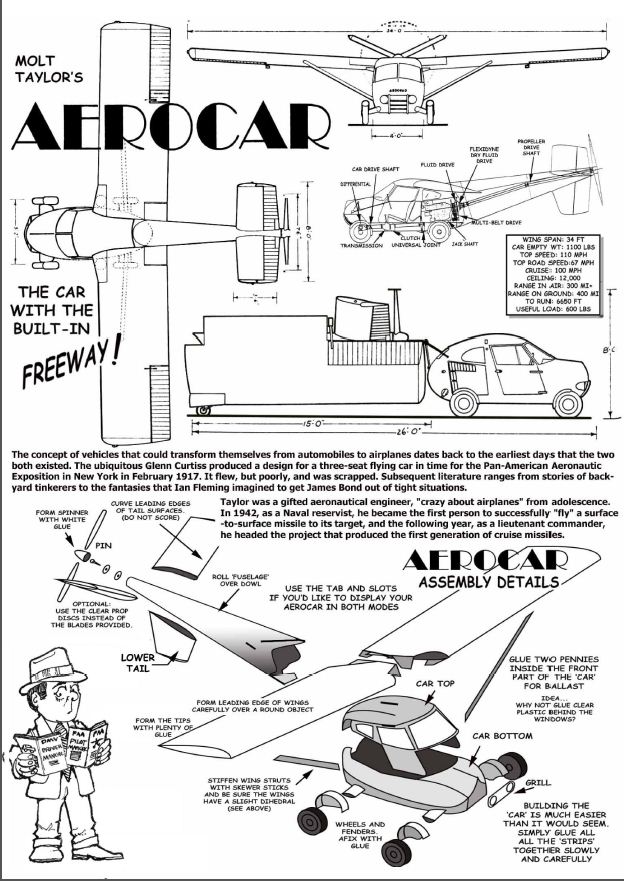



 These images of a cabin/clear windshield Aerocar were sent in by
These images of a cabin/clear windshield Aerocar were sent in by